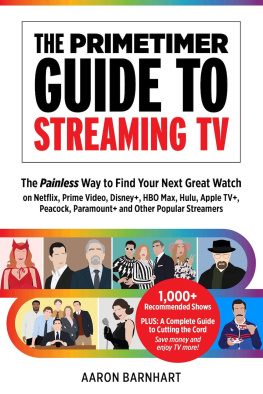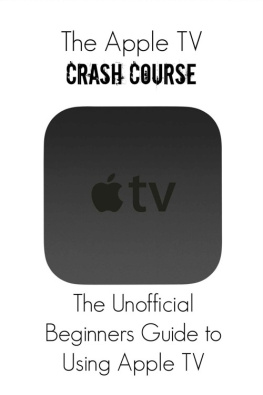Amazon
Jeff Bezos, founder and executive chairman, former CEO
Andy Jassy, CEO
Mike Hopkins, senior vice president, Prime Video and Amazon Studios
Jennifer Salke, head of Amazon Studios
Albert Cheng, chief operating officer, co-head of television
Roy Price, former head of global video content and Amazon Studios
Bob Berney, former head of marketing and distribution, Amazon Studios
Apple
Steve Jobs, late cofounder and CEO
Tim Cook, CEO
Zack Van Amburg, co-head of Apple TV+
Jamie Erlicht, co-head of Apple TV+
Eddy Cue, senior vice president, internet software and services
AT&T/WarnerMedia
Randall Stephenson, former CEO, AT&T
John Stankey, CEO, AT&T; former CEO, WarnerMedia
Jason Kilar, CEO, WarnerMedia
Andy Forssell, executive vice president and general manager, WarnerMedia direct-to-consumer
Bob Greenblatt, former chairman, WarnerMedia
Kevin Reilly, former chief content officer, HBO Max
Jeremy Legg, former chief technology officer, WarnerMedia
Richard Plepler, former chairman and CEO, HBO
Comcast/NBCUniversal
Brian Roberts, CEO, Comcast
Steve Burke, former CEO, NBCUniversal
Bonnie Hammer, vice chairman, NBCUniversal
Matt Strauss, chairman, direct-to-consumer and international
Jeff Shell, CEO, NBCUniversal
Netflix
Reed Hastings, cofounder, co-CEO
Marc Randolph, cofounder, former CEO
Ted Sarandos, co-CEO
Cindy Holland, former vice president, content acquisition and original series
Bela Bajaria, vice president, content
Scott Stuber, vice president, original films
Neil Hunt, former chief product officer
Patty McCord, former head of HR
Quibi
Jeffrey Katzenberg, founder
Meg Whitman, CEO
Roku
Anthony Wood, founder, CEO
Scott Rosenberg, senior vice president, platform business
The Walt Disney Co.
Michael Eisner, former chairman and CEO
Bob Iger, former CEO and executive chairman
Bob Chapek, CEO
Kareem Daniel, chairman, media and entertainment distribution
Tom Staggs, former chief operating officer
Kevin Mayer, former chairman, direct-to-consumer and international
Jimmy Pitaro, chairman, ESPN and sports content
John Skipper, former president, ESPN
Ricky Strauss, former president, content and marketing for Disney+
Albert Cheng, former chief product officer, digital media, Disney ABC Television Group
Anne Sweeney, former cochair, Disney Media Networks; former president, Disney ABC Television Group
Variations on a single question pinged across social media, bobbing in a digital sea just as messages in physical bottles once were set adrift.
What are we supposed to do now?!
Society and popular culture were imitating a scene from the film Inception, folding inward on themselves, piece by piece, as fear of the spreading coronavirus reached its peak. Schools, courthouses, museums, sports venues, movie theaters, concert halls, restaurants, and bars all closed their doors. Travel bans and border shutdowns took effect. Social distancing prevailed, with hugs and high fives shunned and everyone instructed to stand six feet apart. Even the Happiest Place on Earth, Disneyland, closed its gates to the public for just the fourth time since its 1955 debut. The previous three occasions, after a presidential assassination, a terrorist attack, and an earthquake, were single-day closures. This time, days without visitors stretched into months without an end in sight.
The U.S. followed Italy, China, South Korea, and other countries in forcing most of its population to hunker down for weeks and leave home only when it was necessary. There was no other term for it: this was quarantine. Derived from the Italian phrase quaranta giorni, translated as forty days, quarantine began as a practice in the fourteenth century as Europe confronted a series of deadly plagues. A casualty rate comparable to the Black Deaths had not yet accrued in this new pandemic, but people were contending with an invisible, inchoate threat that had upended daily life and unsettled the collective consciousness. What, those social media messages-in-bottles implored, would ever fill our yawning void?
Streaming, it turned out, was one of the few medically sound answers to that question. America, already accustomed to spending hours a day in a screen-filled cocoon, would respond to the crisis by serving itself more and bigger portions of comfort food. Traditional television initially saw the benefit of this response, with broadcast viewership in major cities spiking between 10 and 20 percent in a single week in mid-March as frustrated viewers tracked the contagion and its effects on financial markets and the 2020 election.
The momentary lift provided by the nations news obsession didnt lastin fact, it exposed the threadbare nature of the viewing options available through traditional TV. Unless you were committed to constantly monitoring local or national news, there was little else to watch. With network programming disrupted by production shutdowns and the freeze on live eventseverything from reality and awards shows to Saturday Night Live to sports conteststhe pay-TV bundle felt more anachronous than ever. A sudden and intense economic recession, which followed a solid ten-year expansion, accelerated the trend of customers cutting and shaving the cord. Thankfully for traditional cable operators, broadband internet access became more essential a commodity than Purell, and those profit margins remained fat.
Netflix, the leading global streaming service, had long been nagged by Wall Street and the press about when it would finally get in the regular TV game and start carrying live sports or news. Co-CEO Ted Sarandos was asked in 2018, when networks were setting ratings records with day-long coverage of the Senate confirmation hearings for Supreme Court justice Brett Kavanaugh, about Netflixs streaming such an event one day. Were primarily embraced as an entertainment brand, he replied. That kind of watching youre describing is a lot of things, but its not terribly entertaining. Appointment viewing, daily programming schedules, advertising, a ninety-day interval between a films run in theaters and its debut for home audiencesall of the staples of traditional TV and filmwere anathema to Netflix. Its shunning of those customs and relentless focus on delighting customers had helped it reach a massive scale. This singular focus is something Netflix shares with another interloper, Amazon, which thought of movies and TV shows as a glittery lure to attract customersmuch as banks once handed out free toasters for opening an account. When we win a Golden Globe, it helps us sell more shoes, Amazon founder Jeff Bezos once said in a 2016 interview. And it does that in a very direct way. Because if you look at Prime members, they buy more on Amazon than non-Prime members, and one of the reasons they do that is once they pay their annual fee, theyre looking around to see, How can I get more value out of the program?
In quarantine, having access to thousands of shows and films on demand seemed like a not-insignificant consolation prize, something that still could inject a welcome element of familiarity into a disorienting time. But the intensity and duration of this binge-viewing period had no precedent. Im running out of things to watch being stuck at home, tweeted Jason Blum, producer of films like Get Out, Us, and the Purge franchise. Any suggestions? The post elicited more than 1,100 replies and lists were soon flying around the internet with the same ubiquity as recipes and pet pictures.












